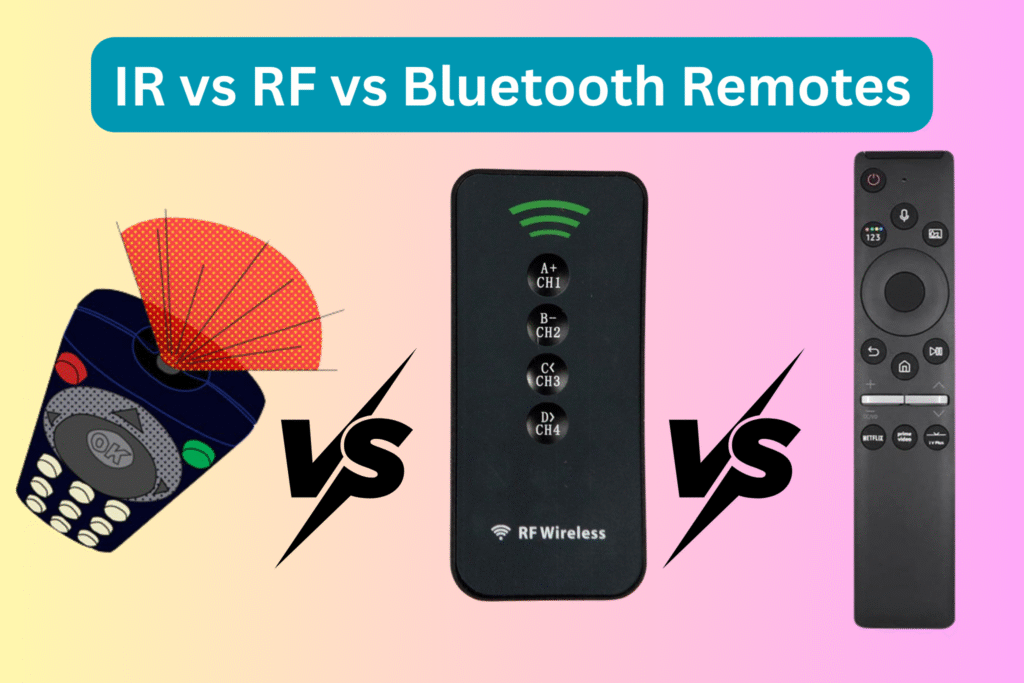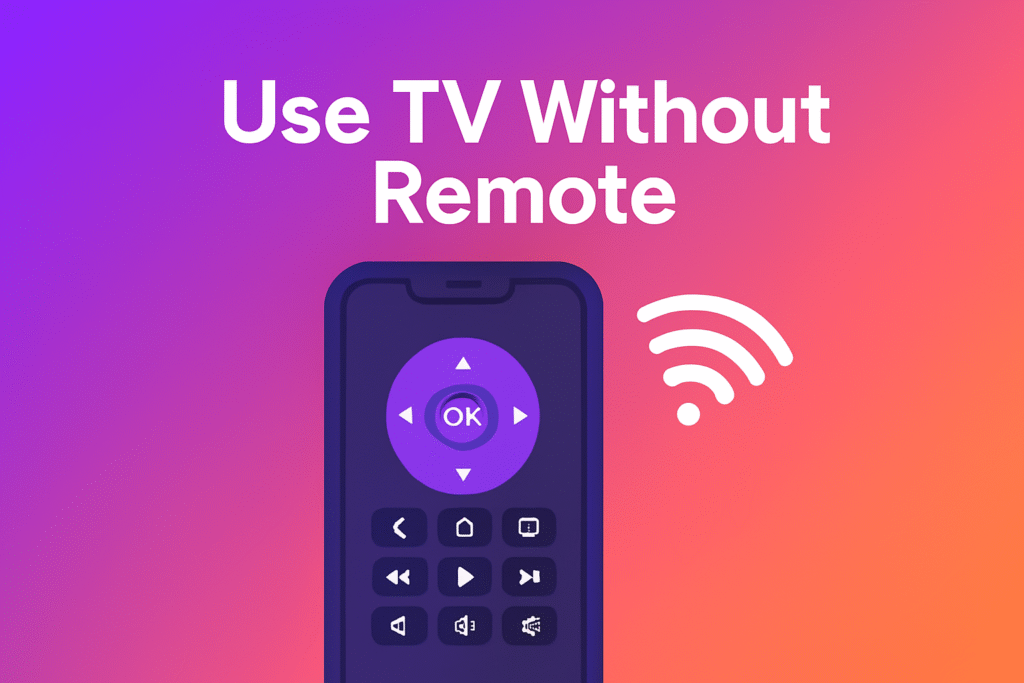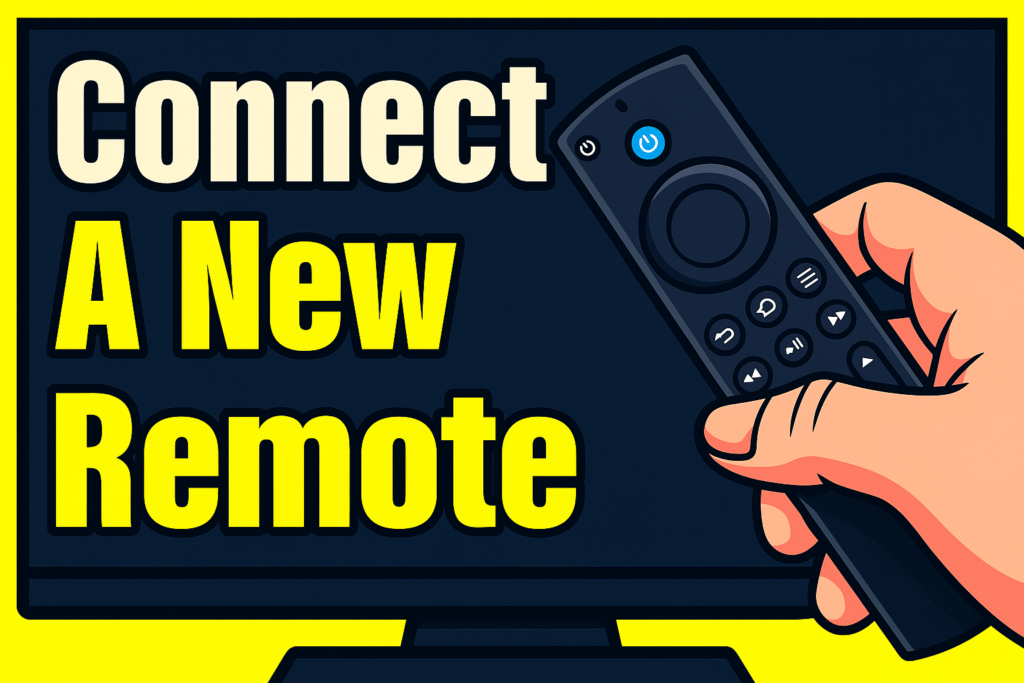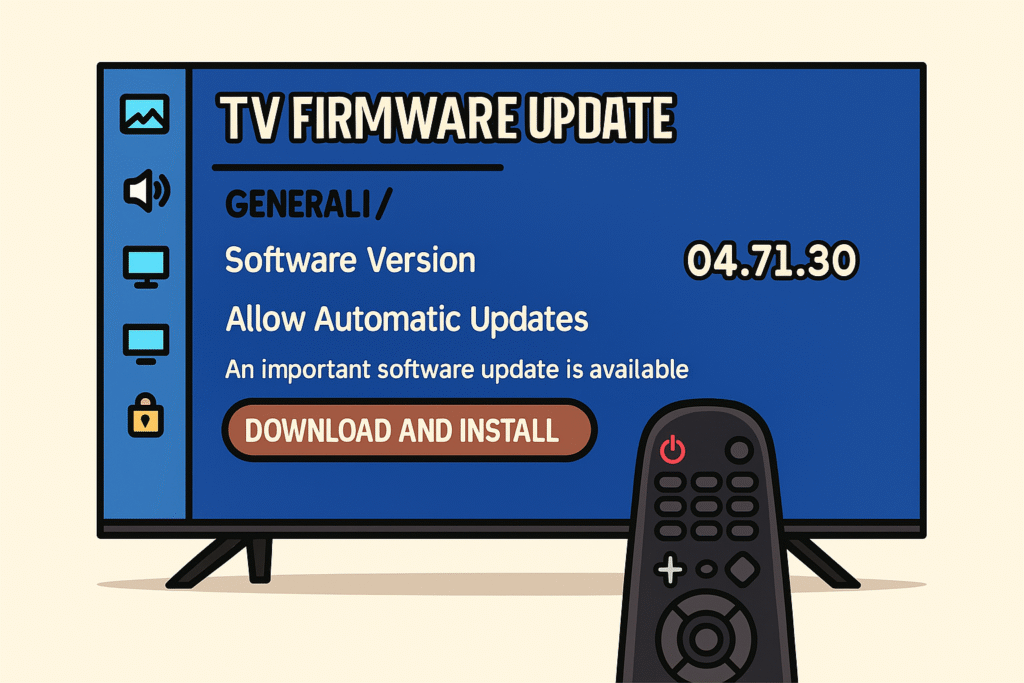Remote controls sit in every home, but not all are the same. Some work with light, some with radio waves, and some connect with Bluetooth. Each type gives a different way to control your TV. To reduce the number of remotes you use, try using HDMI-CEC to control devices with one remote, improving convenience and connectivity.Various technologies are used to transmit commands using TV remotes; these are primarily Infrared (IR), Radio Frequency (RF), and Bluetooth. IR remotes can only work with a line of sight, i.e. you have to point the remote at the TV. In comparison, RF and Bluetooth remotes are not required to face directly, and their location and application are less restricted.
They have advantages and disadvantages per type depending on their range, signal reliability, power consumption, and installation. IR can be simply installed, but RF and Bluetooth can be installed in complex home entertainment systems. In this manual, we will subdivide the key types of TV remotes and discuss their advantages and disadvantages.
What is a TV Remote
A remote control is an electronic device. It is applied to remotely control another device. It usually works wirelessly. People call it a remote or clicker. It has found a wide use in consumer electronics. For example, it can operate a TV, DVD player or media system. It helps the user work on the difficult-to-reach devices. Remote controls are most effective in a short range. This helps in the utilisation of gadgets. Do you want to learn about tv remote controls? Before going into IR, RF, or Bluetooth, make sure to read this guide first; otherwise, some technical details may be difficult to understand.
Types of TV Remote Controls
- Standard TV Remotes
The most basic type of TV remotes is the standard type, the simplest one, with the simplest functions of power, volume, and channel control. They also work with certain TV models. Universal remote controls, on the other hand, can be programmed to operate on multiple devices and are less restrictive and more convenient. To explain, you can use a universal remote to operate your television, DVD player, and sound system instead of numerous remotes.
- Smart TV Remotes
Smart TV remotes are fitted with sophisticated technology such as voice recognition, touch pad and connection features. Such remotes are developed to improve the user experience by ensuring compatibility with smart televisions and other connected devices. The smart TV remote is one of the products of the technological development of remote-control technology. Voice control lets you find your favourite TV shows or change the volume without pressing a button, and makes using your TV more natural.
What is Infrared (IR) Technology?
IR remotes send quick bursts of invisible light to the TV’s IR sensor. Each burst carries a code for a button, like Power or Volume. The TV reads that code and runs the action. You must point the remote at the TV because IR uses light and needs a direct path.
Most IR remotes “ride” those light bursts on a carrier around 38 kHz. IR receivers tune to that number, which helps the TV pick the remote’s signal out of the room light. Many systems also use 36, 40, or 56 kHz.
Typical range stays short about a living room (up to ~30 feet). Objects, bright sun, or a cabinet door can block or weaken the signal. Infrared (IR) is similar to light, as it moves in straight lines and it requires a clear line of sight. It is also commonly employed in television and set-top box remotes, in which a press of a button sends a coded IR signal similar to a button-activated laser pointer. Suppose it were a typical laser pointer, only that the point is not visible, and it has a button input!
Advantages of IR Technology
- Low cost and everywhere: Nearly all TVs support IR, so replacements stay easy and cheap.
- Simple setup: You drop in batteries and point. No pairing steps.
- Low power: IR remotes sip battery since they send short light bursts.
- Tidy control with extenders: IR repeaters can carry the signal from your cabinet to the TV sensor.
Disadvantages of IR Technology
- Needs line of sight: Objects block the beam; glass doors and sunlight can hurt reception.
- Short range: IR covers a room, not a house.
- One-way control: IR sends commands out, but it doesn’t “listen” back, so no easy status or two-way features. RF systems handle that better.
- Shared room light can interfere: Bright sources add noise; the 38 kHz carrier helps, but strong light still causes misses.
Best IR Remotes for Simple and Budget TVs
IR remotes are cheap, easy, and perfect for basic TVs. The GE 4-Device Universal IR Remote is a top pick because it runs up to four devices with simple code setup. The RCA RCR503BZ is another low-cost option that works with TVs, DVDs, and cable boxes, making it a solid backup.

For modern TVs, the One For All Evolve TV Remote stands out with a wide IR angle and a quick app key. The Philips SRP5107 controls up to seven devices and has backlit keys. These remotes stay simple, reliable, and budget-friendly for everyday home use.
What is Radio Frequency (RF) Technology?
RF means radio waves. The remote sends radio waves to the TV or box. The signal goes through walls, doors, and furniture. You don’t need to point at the TV. Radio waves have the advantage that they can travel longer distances and go through walls, unlike IR which acts like light and requires the line of sight.
This is why RF is used in such a wide range of applications like TV antennas, USB dongles in air mice and presentation software- so that it can be wirelessly controlled even when in a different room.
Most RF remotes work on bands like 315 MHz, 433 MHz, or 2.4 GHz. When you press a button, the remote sends a code. The TV or box gets the code and runs the command. RF works from far away, often 50–100 feet.
Advantages of RF Technology
- Works without aiming at the TV.
- Long range, even from another room.
- Goes through walls, doors, and cabinets.
- Can send and get info both ways.
- Good for big rooms or home theatres.
Disadvantages of RF Technology
- Costs more than basic remotes.
- Other devices can disturb the signal.
- Not all TVs use RF remotes.
- Some need a hub or pairing setup.
- Uses more battery power.
Best RF Remotes for Long Range and Hidden Setups
RF remotes are great when you want to control devices from far away or inside cabinets. The Roku Voice Remote Pro is a strong choice. It uses RF and Bluetooth, so you don’t need to point at the TV. Dust and dirt can affect sensor performance, so it’s essential to regularly clean and maintain your TV remote control.
It works through doors, has voice keys, and a rechargeable battery. The Harmony Ultimate One with RF Extender is another good pick. It can run a full home theatre with one button and works through walls.
If you want to turn your old IR remote into RF, the Leapfrog IR-to-RF Extender is a simple tool that sends signals up to 150 feet. These options make life easy when your gear is hidden.
IR remotes are typical, frequently universal, and may have more than one device they can control. There is little interference with them, and often they are only disturbed by strong light sources such as sunlight.
RF remotes are matched to particular receivers and have stronger and longer range connections-but are more susceptible to interference because of the large number of RF devices.
There exist some obvious differences in this infographic in terms of our product specifications.
What is Bluetooth (BT) Technology?
Bluetooth remotes use wireless signals to talk to the TV or device. They work like Bluetooth headphones or speakers. You pair the remote with the TV once. After that, it connects on its own.
Bluetooth does not need direct aim. The signal goes in every direction. You can sit anywhere in the room, and the remote will still work. The range is about 30 feet. Some Bluetooth remotes also support voice. You press the mic button and speak to search, change channels, or open apps.
Smart TVs, Fire TV, Google TV, and LG Magic Remote often use Bluetooth. This makes them better for apps, streaming, and smart features.
Example: BT-250
You use the IR-200 remote to control your TV by its learning feature. You can control: Power ON/OFF, Volume and Input Source. You will need the factory remote control of your TV to do this.
Advantages of Bluetooth Technology
- No line of sight needed.
- Good range, up to 30 feet.
- Supports voice commands.
- Connects fast after pairing.
- Works well with smart TVs and streaming sticks.
Disadvantages of Bluetooth Technology
- Costs more than IR remotes.
- Needs pairing before use.
- May lose connection sometimes.
- Uses more battery than IR.
- Not all TVs support Bluetooth remotes.
Best Bluetooth Remotes for Smart TVs and Streaming Devices
Bluetooth remotes are easy to use and do not need pointing. The Roku Voice Remote Pro is a top pick. It has Bluetooth and voice keys, backlit buttons, and a rechargeable battery that lasts months. The Samsung Smart TV Remote is simple and quick.
It gives one-touch access to apps like Netflix and Prime, and you can use voice with Bixby to change shows. The Apple TV Siri Remote is another great option. It connects with Bluetooth 5, has a smooth touchpad, and charges with USB-C.
These Bluetooth remotes work well with smart TVs and streaming devices. They give comfort, voice search, and faster app control.
Comparison Table of IR, RF and BT Remote Controls
| Feature | Infrared (IR) Remote | Bluetooth (BT) Remote | Radio Frequency (RF) Remote |
| Signal | A light beam needs a direct point | Wireless link, no point needed for the device | Radio waves, no point needed |
| Range | 20-30 ft (room only) | Up to 30 ft | 50-100 (longer range) |
| Through Walls | No | Yes | Yes |
| Setup | Add batteries, ready to use | Need pairing once | Needs pairing or a hub sometimes |
| Features | Power, volume, channel only | Voice keys, app control, smart features | Long range, some two-way feedback |
| Interference | Sunlight or objects block it | Wi-Fi may cause drops | Other radios may clash |
| Battery Use | Very low | Medium | High |
| Cost | Cheapest | Mid-price | Most expensive |
| Best Product | GE Universal IR Remote | Samsung Smart TV Bluetooth Remote | Roku Voice Remote Pro (RF+Bluetooth) |
Which Remote Technology is Best for You?
The right remote depends on your setup. IR remotes like the GE Universal IR Remote are best for simple TVs and low cost. Bluetooth remotes such as the Samsung Smart TV Bluetooth Remote or LG Magic Remote work well with smart TVs, apps, and voice keys. Bluetooth and smart remotes can help you update your TV firmware using a remote, keeping your device features up to date.
RF remotes like the Roku Voice Remote Pro shine in large rooms or when devices sit inside cabinets. If you want one for many devices, a universal remote with Bluetooth and IR, such as the One For All Smart Control Pro 6, is a strong pick. Choose what fits your home.
The decision of the right remote is a matter of convenience. IR remotes are visible only when facing in the same direction. With RF remotes you have greater freedom and you can use your fan anywhere in the room even when you are in bed.
Therefore, it is also important to look at convenience along with air movement and efficiency when changing your fan. TVS Green iDrive Fans RF remotes are comfortable, energy efficient and easy to control.
Other Remote Technologies You Should Know About
In addition to IR, Bluetooth, and RF, there are a number of other remote-control technologies that are increasingly popular as TVs and smart houses develop. These more recent approaches are aimed at enhancing the connection, minimising interference, and introducing intelligent capabilities far more advanced than merely switching channels.
Zigbee / RF4CE is one of the technologies used in cable TV and smart homes. It uses very minimal power, supports two-way communication, and provides reliable performance even in situations where there is a high number of wireless devices.
The other possible alternative is Wi-Fi Direct, where your remote (or phone) and TV can be connected directly without the use of a router. This provides both high bandwidth and low latency, and can be used in streaming, screen mirroring or state-of-the-art functionality on smart televisions.
Security is important like never before as remotes become smarter and more connected. Zigbee and Wi-Fi Direct are modern systems that typically encrypt their commands so that they cannot be easily intercepted, hijacked or stolen.
Lastly, phone-based remotes using an app and smartphone transform your phone into a universal controller. Brands such as Roku, Google TV, or Samsung SmartThings have apps that allow you to turn your TV on and off, find what you want by voice or voice, or use the keyboard on your phone to enter a query.
Such technologies focus on the concept of remote control, no longer involving simple button presses but being built into the overall smart home ecosystem where control is easier, safer and more flexible than ever before.
Conclusion
TV remote controls look small, but they change how we enjoy time at home. IR, Bluetooth, and RF all give us different ways to stay in control. Each one has its place, from simple rooms to smart homes and even big theatres.
The truth is, the best remote is the one that fits your life. Maybe it’s the low-cost IR for quick use. Maybe it’s Bluetooth with voice for your smart TV. Or maybe it’s RF that reaches far and cuts through walls.
Do not stress over problems. Every remote has a solution. What matters is comfort, ease, and peace of mind. When your remote work works right, you focus less on buttons and more on the moments family laughs, quiet nights, and favourite shows.
Choose the type that makes life simple. If your remote stops working, the first step is to replace TV remote batteries to restore proper function. In the end, the right remote is not just about the TV. It’s about joy in your living room.
Frequently Asked Questions (FAQ)
How does a TV remote signal work?
A remote sends invisible signals that are encoded with commands using an infrared (IR) remote. These signals are received by the built-in sensor of the TV and processed by performing the requested operation, e.g. switching channels or modifying the volume.
Do Bluetooth and RF remotes need line of sight like IR?
No. Both Bluetooth and RF remotes are wireless and do not require a clear line of sight like IR remotes, which require direct pointing at the TV. This allows them to be more versatile in the room or even in a different room in other situations.
Can I use a universal remote for all types of remotes?
Yes, but with limits. The majority of universal remotes use IR, but some more advanced products have the option of Bluetooth or RF with a separate hub. When you need to manage several smart home devices, find the universal remote that has hybrid options (IR + Bluetooth + RF).
Why do RF and Bluetooth remotes drain batteries faster?
Continuous wireless communication in RF and Bluetooth remotes burns more energy than short bursts of light in IR remotes. To compensate for this disadvantage, some of the models are now fitted with rechargeable batteries.
Are smartphone apps good replacements for physical remotes?
Yes, many tasks can be performed by smartphone remote applications, including channel switching, voice searches, and typing on a keyboard instead of using a physical remote. They do have Wi-Fi, however, and might not be as fast or convenient as just pushing a physical button, particularly in daily use.





